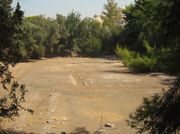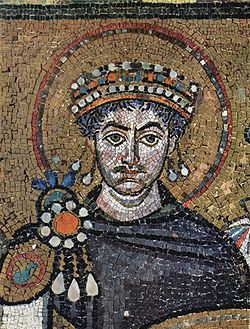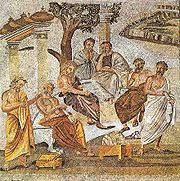Platonic Academy
 |
| Part of a series on |
| Plato |
|---|
| Early life · Works · Platonism Epistemology · Idealism / Realism Theory of Forms Form of the Good Third man argument Euthyphro dilemma · Five regimes Philosopher king |
| Allegories and metaphors |
| Ring of Gyges · The cave The divided line · The sun Ship of state · Myth of Er The chariot |
| Related articles |
| The Academy in Athens Socratic problem Commentaries on Plato Middle Platonism · Neoplatonism Neoplatonism and Christianity |
The Academy (Ancient Greek: Ἀκαδήμεια) was founded by Plato in ca. 387 BC in Athens. Aristotle studied there for twenty years (367 BC - 347 BC) before founding his own school, the Lyceum. The Academy persisted throughout the Hellenistic period as a skeptical school, until coming to an end after the death of Philo of Larissa in 83 BC. Although philosophers continued to teach Plato's philosophy in Athens during the Roman era, it was not until AD 410 that a revived Academy was re-established as a center for Neoplatonism, persisting until 529 AD when it was finally closed down by Justinian I.
Contents |
Site
Before the Akademia was a school, and even before Cimon enclosed its precincts with a wall,[1] it contained a sacred grove of olive trees dedicated to Athena, the goddess of wisdom, outside the city walls of ancient Athens.[2] The archaic name for the site was Hekademia (Ἑκαδήμεια), which by classical times evolved into Akademia and was explained, at least as early as the beginning of the 6th century BC, by linking it to an Athenian hero, a legendary "Akademos".
The site of the Academy was sacred to Athena and other immortals; it had sheltered her religious cult since the Bronze Age, a cult that was perhaps also associated with the hero-gods the Dioscuri (Castor and Polydeuces), for the hero Akademos associated with the site was credited with revealing to the Divine Twins where Theseus had hidden Helen. Out of respect for its long tradition and the association with the Dioscuri, the Spartans would not ravage these original "groves of Academe" when they invaded Attica,[3] a piety not shared by the Roman Sulla, who axed the sacred olive trees of Athena in 86 BC to build siege engines.
Among the religious observations that took place at the Akademeia was a torchlit night race from altars within the city to Prometheus' altar in the Akademeia. Funeral games also took place in the area as well as a Dionysiac procession from Athens to the Hekademeia and then back to the polis.[4] The road to Akademeia was lined with the gravestones of Athenians.
The site of the Academy was located near Colonus. The walk from Athens to the Academy was 6 stadia (1 mile) from the Dipylon gates (Kerameikos). The site was rediscovered in the 20th century, in modern Akadimia Platonos; considerable excavation has been accomplished and visiting the site is free.[5]
Plato's Academy
What was later to be known as Plato's school probably originated around the time Plato acquired inherited property at the age of thirty, with informal gatherings which included Theaetetus of Sunium, Archytas of Tarentum, Leodamas of Thasos, and Neoclides.[6] According to Debra Nails, Speusippus "joined the group in about 390." She claims, "It is not until Eudoxus of Cnidos arrives in the mid-380s that Eudemus recognizes a formal Academy." There is no historical record of the exact time the school was officially founded, but modern scholars generally agree that the time was the mid-380s, probably sometime after 387, when Plato is thought to have returned from his first visit to Italy and Sicily.[7] Originally, the location of the meetings was Plato's property as often as it was the nearby Academy gymnasium; this remained so throughout the fourth century.[8]
Though the Academic club was exclusive, not open to the public,[9] it did not, during at least Plato's time, charge fees for membership.[10] Therefore, there was probably not at that time a "school" in the sense of a clear distinction between teachers and students, or even a formal curriculum.[11] There was, however, a distinction between senior and junior members.[12]
In at least Plato's time, the school did not have any particular doctrine to teach; rather, Plato (and probably other associates of his) posed problems to be studied and solved by the others.[13] There is evidence of lectures given, most notably Plato's lecture "On the Good"; but probably the use of dialectic was more common.[14] Above the entrance to the Academy was inscribed the phrase "Let None But Geometers Enter Here."
Many have imagined that the Academic curriculum would have closely resembled the one canvassed in Plato's Republic.[15] Others, however, have argued that such a picture ignores the obvious peculiar arrangements of the ideal society envisioned in that dialogue.[16] The subjects of study almost certainly included mathematics as well as the philosophical topics with which the Platonic dialogues deal, but there is little reliable evidence.[17] There is some evidence for what today would be considered strictly scientific research: Simplicius reports that Plato had instructed the other members to discover the simplest explanation of the observable, irregular motion of heavenly bodies: "by hypothesizing what uniform and ordered motions is it possible to save the appearances relating to planetary motions."[18] (According to Simplicius, Plato's colleague Eudoxus was the first to have worked on this problem.)
Plato's Academy is often said to have been a school for would-be politicians in the ancient world, and to have had many illustrious alumni.[19] In a recent survey of the evidence, Malcolm Schofield, however, has argued that it is difficult to know to what extent the Academy was interested in practical (i.e., non-theoretical) politics since much of our evidence "reflects ancient polemic for or against Plato."[20]
Later history of the Academy

Diogenes Laërtius divided the history of the Academy into three: the Old, the Middle, and the New. At the head of the Old he put Plato, at the head of the Middle Academy, Arcesilaus, and of the New, Lacydes. Sextus Empiricus enumerated five divisions of the followers of Plato. He made Plato founder of the first Academy; Arcesilaus of the second; Carneades of the third; Philo and Charmadas of the fourth; Antiochus of the fifth. Cicero recognised only two Academies, the Old and New, and made the latter commence with Arcesilaus.[21]
Old Academy
Plato's immediate successors as "scholarch" of the Academy were Speusippus (347-339 BC), Xenocrates (339-314 BC), Polemo (314-269 BC), and Crates (c. 269-266 BC). Other notable members of the Academy include Aristotle, Heraclides, Eudoxus, Philip of Opus, and Crantor.
Middle Academy
Around 266 BC Arcesilaus became scholarch. Under Arcesilaus (c. 266-241 BC), the Academy strongly emphasized Academic skepticism. Arcesilaus was followed by Lacydes of Cyrene (241-215 BC), Evander and Telecles (jointly) (205-c. 165 BC), and Hegesinus (c. 160 BC).
New Academy
The New or Third Academy begins with Carneades, in 155 BC, the fourth scholarch in succession from Arcesilaus. It was still largely skeptical, denying the possibility of knowing an absolute truth. Carneades was followed by Clitomachus (129-c. 110 BC) and Philo of Larissa ("the last undisputed head of the Academy," c. 110-84 BC).[22][23] According to Jonathan Barnes, "It seems likely that Philo was the last Platonist geographically connected to the Academy."[24]
Around 90 BC, Philo's student Antiochus of Ascalon began teaching his own rival version of Platonism rejecting Skepticism and advocating Stoicism, which began a new phase known as Middle Platonism.
The Destruction of the Academy

When the First Mithridatic War began in 88 BC, Philo of Larissa left Athens, and took refuge in Rome, where he seems to have remained until his death.[25] In 86 BC, Lucius Cornelius Sulla laid siege to Athens, and conquered the city, causing much destruction. It was during the siege that he laid waste to the Academy, for "he laid hands upon the sacred groves, and ravaged the Academy, which was the most wooded of the city's suburbs, as well as the Lyceum."[26]
The destruction of the Academy seems to have been so severe as to make the reconstruction and re-opening of the Academy impossible.[27] When Antiochus returned to Athens from Alexandria, c. 84 BC, he resumed his teaching but not in the Academy. Cicero, who studied under him in 79/8 BC, refers to Antiochus teaching in a gymnasium called Ptolemy. Cicero describes a visit to the site of the Academy one afternoon, which was "quiet and deserted at that hour of the day"[28]
Neoplatonic Academy

Philosophers continued to teach platonism in Athens during the Roman era, but it was not until the early 5th century (c. 410) that a revived Academy was established by some leading Neoplatonists.[29] The origins of Neoplatonist teaching in Athens are uncertain, but when Proclus arrived in Athens in the early 430's, he found Plutarch of Athens and his colleague Syrianus teaching in an Academy there. The Neoplatonists in Athens called themselves "successors" (diadochoi, but of Plato) and presented themselves as an uninterrupted tradition reaching back to Plato, but there cannot have actually been any geographical, institutional, economic or personal continuity with the original Academy.[30] The school seems to have been a private foundation, conducted in a large house which Proclus eventually inherited from Plutarch and Syrianus.[31] The heads of the Neoplatonic Academy were Plutarch of Athens, Syrianus, Proclus, Marinus, Isidore, and finally Damascius. The Neoplatonic Academy reached its apex under Proclus (died 485).
The last "Greek" philosophers of the revived Academy in the 6th century were drawn from various parts of the Hellenistic cultural world and suggest the broad syncretism of the common culture (see koine): Five of the seven Academy philosophers mentioned by Agathias were Syriac in their cultural origin: Hermias and Diogenes (both from Phoenicia), Isidorus of Gaza, Damascius of Syria, Iamblichus of Coele-Syria and perhaps even Simplicius of Cilicia.[30]
At a date often cited as the end of Antiquity, the emperor Justinian closed the school in 529 A.D. (Justinian actually closing the school has come under some recent scrutiny[32]). The last Scholarch of the Academy was Damascius (d. 540). According to the sole witness, the historian Agathias, its remaining members looked for protection under the rule of Sassanid king Khosrau I in his capital at Ctesiphon, carrying with them precious scrolls of literature and philosophy, and to a lesser degree of science. After a peace treaty between the Persian and the Byzantine empire in 532, their personal security (an early document in the history of freedom of religion) was guaranteed.
It has been speculated that the Academy did not altogether disappear.[30][33] After his exile, Simplicius (and perhaps some others), may have travelled to Harran, near Edessa. From there, the students of an Academy-in-exile could have survived into the 9th century, long enough to facilitate the Arabic revival of the Neoplatonist commentary tradition in Baghdad.[33]
One of the earliest academies established in the east was the 7th century Academy of Gundishapur in Sassanid Persia.
Notes
- ↑ Plutarch Life of Cimon xiii:7
- ↑ Thucydides ii:34
- ↑ Plutarch, Life of Theseus xxxii
- ↑ Paus. i 29.2, 30.2; Plut. Vit. Sol. i 7
- ↑ greeceathensaegeaninfo.com
- ↑ pp. 5-6, D. Nails, "The Life of Plato of Athens", in H. Benson (ed.), A Companion to Plato, Blackwell Publishing 2006.
- ↑ pp. 19-20, W. K. C. Guthrie, A History of Greek Philosophy, vol. 4, Cambridge University Press 1975; p. 1, R. Dancy, "Academy", in D. Zeyl (ed.), Encyclopedia of Classical Philosophy, Greenwood Press 1997. I. Mueller gives a much broader time frame - "...some time between the early 380s and the middle 360s..." - perhaps reflecting our real lack of evidence about the specific date (p. 170, "Mathematical Method & Philosophical Truth", in R. Kraut (ed.), The Cambridge Companion to Plato, Cambridge University Press 1992).
- ↑ D. Sedley, "Academy", in the Oxford Classical Dictionary, 3rd ed.; p. 4, J. Barnes, "Life and Work", in The Cambridge Companion to Aristotle, Cambridge University Press 1995; J. Barnes, "Academy", E. Craig (Ed.), Routledge Encyclopedia of Philosophy, Routledge 1998, accessed 13 Sept 2008, from http://www.rep.routledge.com/article/A001.
- ↑ p. 31, J. Barnes, Aristotle: A Very Short Introduction, Oxford University Press 2000.
- ↑ p. 170, Mueller, "Mathematical Method & Philosophical Truth"; p. 249, D. Nails, The People of Plato, Hackett 2002.
- ↑ pp. 170-171, Mueller, "Mathematical Method & Philosophical Truth"; p. 248, Nails, The People of Plato.
- ↑ Barnes, "Academy".
- ↑ p. 2, Dancy, "Academy".
- ↑ p. 2, Dancy, "Academy"; p. 21, Guthrie, A History of Greek Philosophy, vol. 4; p. 34-36, Barnes, Aristotle: A Very Short Introduction.
- ↑ p. 22, Guthrie, A History of Greek Philosophy, vol. 4.
- ↑ pp. 170-171, Mueller, "Mathematical Method & Philosophical Truth".
- ↑ M. Schofield, "Plato", in E. Craig (Ed.), Routledge Encyclopedia of Philosophy, Routledge 1998/2002, retrieved 13 Sept 2008, from http://www.rep.routledge.com/article/A088 ; p. 32, Barnes, Aristotle: A Very Short Introduction.
- ↑ Simplicius, Commentary on Aristotle's "On the Heavens" 488.7-24, quoted on p. 174, Mueller, "Mathematical Method & Philosophical Truth".
- ↑ p. 23, Guthrie, A History of Greek Philosophy, vol. 4; G. Field, "Academy", in the Oxford Classical Dictionary, 2nd ed.
- ↑ p. 293, "Plato & Practical Politics", in Schofield & C. Rowe (eds.), Greek & Roman Political Thought, Cambridge University Press 2000.
- ↑ Charles Anthon, (1855), A Classical Dictionary, page 6
- ↑ Oxford Classical Dictionary, 3rd ed. (1996), s.v. "Philon of Larissa."
- ↑ See the table in The Cambridge History of Hellenistic Philosophy (Cambridge University Press, 1999), pp. 53-54.
- ↑ "Academy", E. Craig (Ed.), Routledge Encyclopedia of Philosophy, Routledge 1998, accessed 14 Sept 2008, from http://www.rep.routledge.com/article/A001.
- ↑ Giovanni Reale, John R. Catan, 1990, A History of Ancient Philosophy: The schools of the Imperial Age, page 207. SUNY Press
- ↑ Plutarch, Sulla 12; cf. Appian, Roman History xii, 5.30
- ↑ Giovanni Reale, John R. Catan, 1990, A History of Ancient Philosophy: The schools of the Imperial Age, page 208. SUNY Press
- ↑ Cicero, De Finibus, book 5
- ↑ Alan Cameron, "The last days of the Academy at Athens," in Proceedings of the Cambridge Philological Society vol 195 (n.s. 15), 1969, pp 7-29.
- ↑ 30.0 30.1 30.2 Gerald Bechtle, Bryn Mawr Classical Review of Rainer Thiel, Simplikios und das Ende der neuplatonischen Schule in Athen. Stuttgart, 1999 (in English).
- ↑ The Cambridge Ancient History, (1970), Volume XIV, page 837. Cambridge University Press.
- ↑ see also Victoria Erhart, The Context and Contents of Priscianus of Lydia's Solutionum ad Chosroem, Catholic University of America, 1998 [1]
- ↑ 33.0 33.1 Richard Sorabji, (2005), The Philosophy of the Commentators, 200-600 AD: Psychology (with Ethics and Religion), page 11. Cornell University Press
References
- H. Cherniss, The Riddle of the Early Academy, CUP (1945).
- R. E. Wycherley, Peripatos: The Athenian Philosophical Scene. Greece & Rome, parts I (1961) and II (1962).
- J. Glucker, Antiochus and the Late Academy Göttingen: Vandenhoeck & Ruprecht (1978).
- R. M. Dancy Two Studies in the Early Academy SUNY (1991).
- J. Dillon, The Heirs of Plato. A Study of the Old Academy (347 - 274 BC) OUP (2003).
See also
- Academy of Athens (modern)
- Hellenistic philosophy
- Platonism
- Peripatetic school
- Stoicism
- Epicureanism
- Neoplatonism

